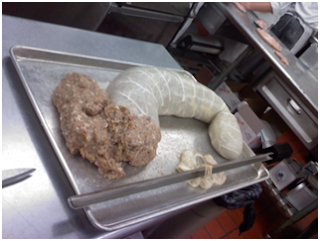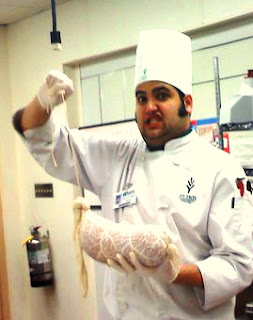Today in class I learned a lot about some of the different aspects of organic foods and more specifically organic farming. I thought I did a decent job with my research that I put into with the presentation but there were a couple of key elements that I left out. One specific part that Chef pointed out that does not really apply to the chain supermarkets selling organic produce. The “know your farmer” phrase can and still does play a major role in some of the most highly respected restaurants in the US and buying organic can mean that I am purchasing a superior product than that of a conventional item. I learned that through proper practices in organic farming the soil becomes rich in nutrients and will end up producing a better and more satisfying product. And, the word "organic" on a label does not always mean that the farm is using proper practices to develop nutrient rich soils.
 Also in class today I learned a lot about the difference between composed salads and the regular salads that I would see served at a lot of the chain restaurants in Indianapolis. I was one of the people that took the practical final and had no idea about any of the base, body elements (probably because I never had Chef England) that any salad served at a restaurant is supposed to have. My thoughts before were always lettuce and then you throw some raw vegetables on top and overload with dressing. Appetizing? Absolutely not. So, producing these salads today gave me such a better perspective on how a true salad should be composed and how there should be thought and careful critique as an end result. I really enjoyed setting up the room today and I was very appreciative to see the time that all of us put into trying to make each plate look good. At the very least, it was certainly better than any house salad I have forced myself to eat at our (insert chain restaurant name here)!
Also in class today I learned a lot about the difference between composed salads and the regular salads that I would see served at a lot of the chain restaurants in Indianapolis. I was one of the people that took the practical final and had no idea about any of the base, body elements (probably because I never had Chef England) that any salad served at a restaurant is supposed to have. My thoughts before were always lettuce and then you throw some raw vegetables on top and overload with dressing. Appetizing? Absolutely not. So, producing these salads today gave me such a better perspective on how a true salad should be composed and how there should be thought and careful critique as an end result. I really enjoyed setting up the room today and I was very appreciative to see the time that all of us put into trying to make each plate look good. At the very least, it was certainly better than any house salad I have forced myself to eat at our (insert chain restaurant name here)!





